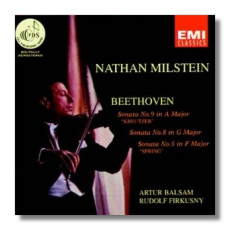
The Internet's Premier Classical Music Source
Related Links
- Beethoven Reviews
- Latest Reviews
- More Reviews
-
By Composer
-
Collections
DVD & Blu-ray
Books
Concert Reviews
Articles/Interviews
Software
Audio
Search Amazon
Recommended Links
Site News
 CD Review
CD Review
Ludwig van Beethoven

- Concerto for Piano #5 "Emperor" in E Flat Major, Op. 73 (1809)
- Symphony #7 in A Major, Op. 92 (1812)
Rudolf Firkušný, piano
Pittsburgh Symphony Orchestra/William Steinberg
EMI Classics 66888 ADD part monaural 75:50


Violin Sonatas
- Sonata for Violin #5 "Spring" in F Major, Op. 24 (1801)
- Sonata for Violin #8 in G Major, Op. 30 #3 (1802)
- Sonata for Violin #9 "Kreutzer" in A Major, Op. 47 (1803)
Nathan Milstein, violin
Artur Balsam, Rudolf Firkušný, piano
EMI Classics 66874 ADD 59:44
These two discs contain material that originally appeared on the Capitol label. The "Emperor" Concerto and the Seventh Symphony were recorded in 1957; the sonatas were recorded in 1957 and 1958.
The Czech-born pianist, Rudolf Firkušný (1912-1994) studied piano with Artur Schnabel, and so it comes as no surprise that his strong points were the Czech repertoire and the music of Beethoven. Like Schnabel, Firkušný also composed, and perhaps it is their experience as composer-pianists that made them more sensitive to the wishes of the composer than to the whims of the performer. Firkušný's "Emperor" is sane, well played, and very traditional – Beethoven fondly looking backward, not revolting against the status quo. If one accepts such a premise, then this "Emperor" is quite beautiful. William Steinberg was a very dependable conductor of the German repertoire, and he made many excellent recordings in Pittsburgh (for Capitol and Command), and also with the Boston Symphony Orchestra (for RCA Victor and Deutsche Grammophon). The neglect of his recorded legacy is slowly being corrected. As Firkušný's partner in the concerto, he shapes and blends orchestral detail with care. It's possible to hear more of what the orchestra is doing here than on many other recordings, and yet it isn't obtrusive. The little gap between the soloist's final cadenza and the final orchestral ritornello is perplexing, however. In the symphony, Steinberg's approach is similarly conservative and detail-oriented. It has the feel of Grecian architecture, not a Dionysian orgy.
Milstein's sonata disc contains treasurable performances. I first got to know the "Kreutzer" Sonata from this recording, when it was issued on a budget Pickwick LP in fake stereo. The fake stereo is gone now, much to the recording's benefit. Milstein plays these three sonatas much as one imagines that they would have been played in Beethoven's time. Vibrato is used sparingly, and a feeling for Classical balance and proportion is always present. Here, more than in the Romantic repertoire, Milstein's reedy tone and self-effacing emotional control produce quietly glorious musical rewards. Balsam (Sonatas #8 and 9) and Firkušný (the
"Spring" Sonata) are ideal partners. Their playing is serious but not tough, and the unvarnished grace of Beethoven's inspiration shines through. The sound is good, but better in the two later sonatas, where, although the recording is monaural, the two instruments are more evenly balanced.
Copyright © 1999, Raymond Tuttle


















